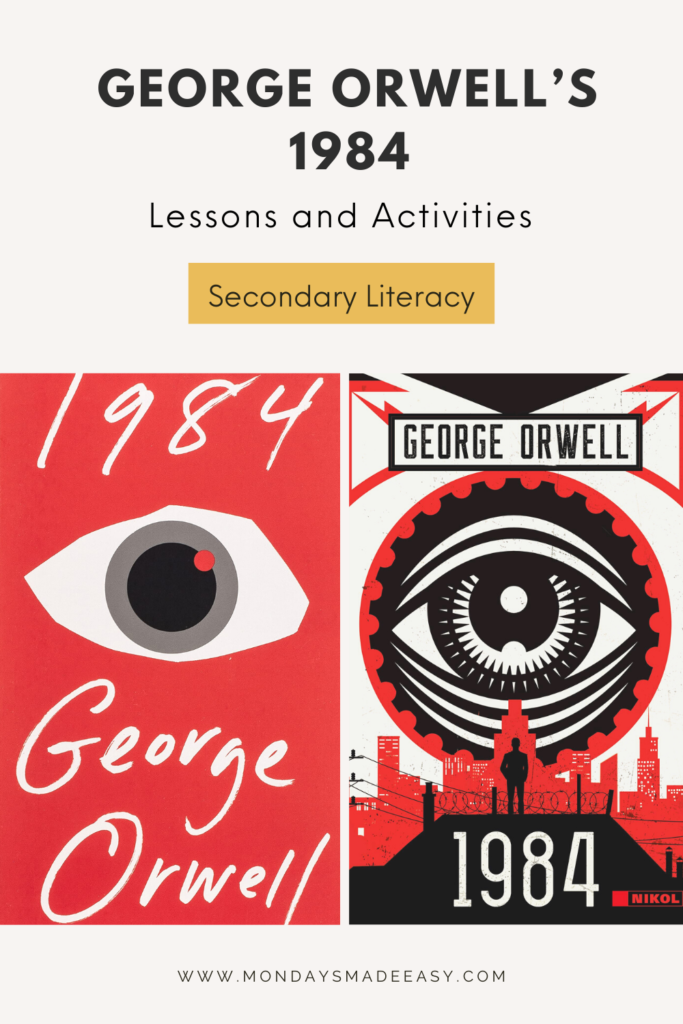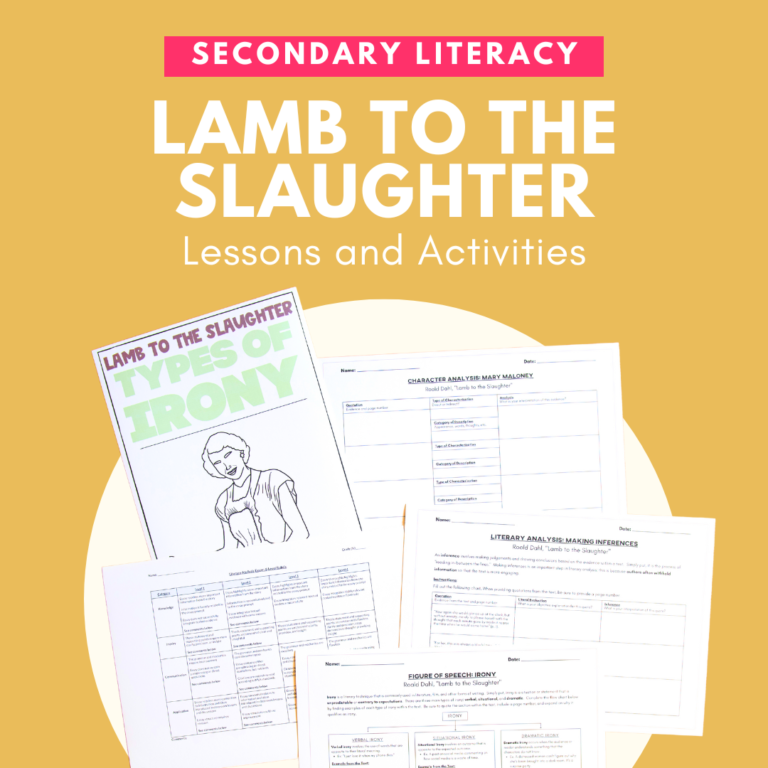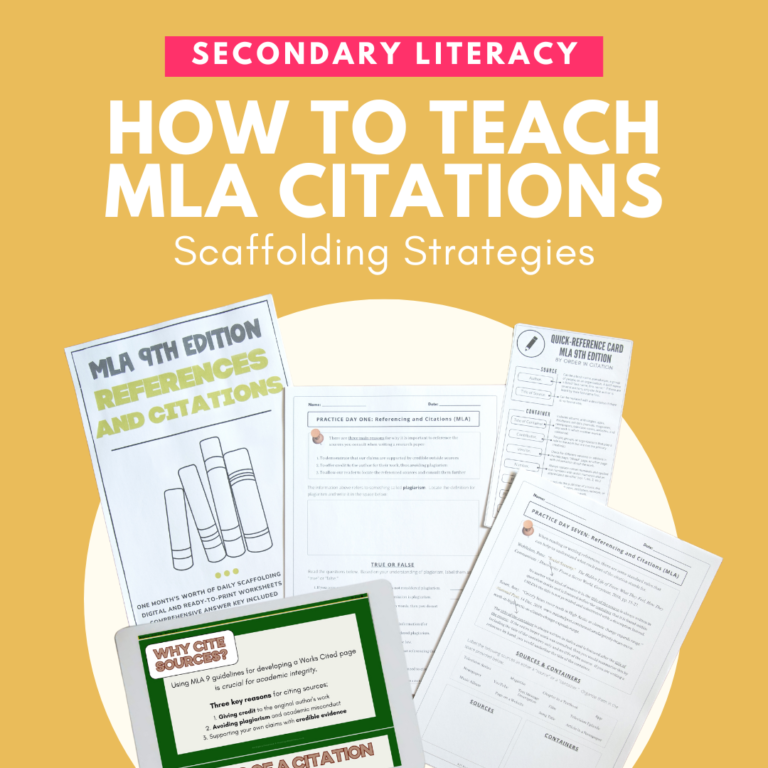I try to read George Orwell’s 1984 every year. This novel is captivating from the very first line; Orwell’s composition never ceases to amaze me. But what I find most fascinating about this novel is that it becomes seemingly more relevant as time goes on. As our world continues to change, I begin to notice more parallels between society and Orwell’s 1984 – all the more reason to introduce this novel to your high school students.
Whether you’re teaching 1984 for the first time or, like me, turn back to it year after year, I trust that this blog post will have lessons and activities applicable to your unit. Feel free to adapt these lessons to your students and to your own style of teaching!

What grade should I teach 1984?
Are your students the right match for Orwell’s 1984? This depends on a few factors. First, it is worth considering your students’ cultural backgrounds and familiarity with socialism and communism. If you teach English at a school located in a nation that was formerly a part of the Soviet Union or Eastern Bloc, your students will have a considerable amount of background knowledge for this novel.
Students studying in countries located in the global East may also have pre-existing background knowledge. This is because of their geographical relationship with the communist countries of Asia. But a word of caution if you teach at an international school: if you’ve never read 1984, keep in mind that it is a harsh critique of socialism. You may wish to take this into consideration if the demographic of your classroom is entangled with the communist or socialist nations of today.
Another consideration is your students’ understanding of “fake news“. Are your students familiar with the spread of false information in mainstream media? Nowadays, media literacy is an important component of almost any curriculum. However, depending on where you live, your students may have abundant experience with this concept. This will help them better understand 1984.
Generally speaking, the Lexile level of 1984 indicates that this novel is best suited for 9th and 10th grade. Given the novel’s artful composition, I’d also recommend it for students enrolled in AP Language and Composition.
What can we learn from Orwell’s 1984?
Orwell’s 1984 is more than just dystopian fiction. This is because you can make endless parallels between society in the novel and the real world today. It doesn’t matter what “today” is – somehow, this book remains relevant.
Overall, 1984 is a novel about class society, the overstep of the government, and the implications of language. It tells the story of Winston Smith, a middle-aged man in search of self-realization. He is held back by the society in which he lives, which robs him of the joys of life and the inherent tendencies that come with them.
The novel depicts communism in Europe through a critical eye. Orwell magnifies propaganda, herd mentality, and social stratification to comment on repeated dynamics of power and oppression throughout human history. The government in 1984 also uses fear to oppress the lower classes within society. 1984 therefore also serves as a window into psychology and mass manipulation.

More Modern Parallels to Orwell’s 1984
A favorite lesson of my students involves connecting 1984 to modern music. After Part 2, Chapter 4—when Winston and Julia hear the prole woman singing—I introduce songs like Rage Against the Machine’s “Testify,” Muse’s “Uprising, “or Radiohead’s “2 + 2 = 5” to underscore the novel’s themes of control and rebellion. Then, you can practice close reading by approaching these song lyrics as poetry. This is a great way to underscore the significance of music in Orwell’s 1984.
Another approach is to challenge students to find their parallels using the main concepts from the novel. For example, I start this activity by having students define “Doublethink,” “The Ministry of Peace,” “The Ministry of Truth,” “The Telescreen” and “Big Brother.” Then, I’ll explore five pre-selected articles and have students connect one of the terms to each example. If my students are particularly keen on being challenged, I’ll have them find their own examples too.

Activities to Teach The Book by Emmanuel Goldstein
Did you know that the “Theory of Oligarchical Collectivism” is the only part of Orwell’s first draft of 1984 that made it into the final cut? This important chapter might feel like an interruption to the story, and your students might find it challenging. It reads like a manifesto, so it might help students to explore it like one.
In light of this, I don’t assign the whole chapter in one sitting. I want to avoid overwhelming my class; to be honest, it’s a little overwhelming for just myself! Make sure you spend some time exploring this chapter together. I also remind students that the plot is about to get really thick after this chapter. This helps to build on the suspense that Orwell was surely trying to create.
It might be helpful to develop prior knowledge of manifestos with your students. You can explore the definition of a manifesto or research examples. Students can also complete a WebQuest on a single manifesto to explore its significance.
I find that many of my students are visual learners and like to explore this chapter with a map. Students can use this to gain a geographic understanding of the novel.
This text is also great for literary analysis. You can assign students the task of exploring the literary devices in this chapter. Some noteworthy examples include analogy, personification, metaphor, paradox, aphorism, and conceit.

Teaching Symbolism in 1984
Orwell’s 1984 is rich with symbolism, and these symbols become more complex over the course of the novel. You can prompt students to search for these symbols and consider the way they evolve. Do this by assigning symbol tracking activity and have students explore the symbols you’ve provided to them.
You can divide students into groups and assign each group a symbol. Alternatively, you can have students track these symbols independently. Students can then select one of the symbols as the topic of a presentation or an essay. This is a great way to assess students’ understanding of the symbol and the relationship to the novel as a whole.
Assessment and Review for 1984
Looking for an exciting and memorable way to review the main concepts from 1984? Why not try an escape room activity! Imagine challenging your students to “escape” from Room 101 by decoding hidden messages and revisiting the most important details from the novel. This 1984 Escape Room isn’t just a review; it’s an immersive, hands-on experience that brings the key events, themes, and characters to life.
Whether you’re gearing up for a final test or simply want a fun way to recap the novel, this activity is a fantastic option to engage your students while reinforcing their understanding of the text. It’s flexible, interactive, and sure to leave a lasting impression.

Orwell’s 1984: A Classic for High School English
The only thing I enjoy more than reading this novel is teaching Orwell’s 1984. With the help of the activities and ideas in this blog post, I hope you enjoy teaching it as well! If you’re looking for more resources to teach 1984, be sure to check out my 1984 Novel Study Unit. In addition to the resources mentioned in this blog post, this bundle also includes bell ringer assessments, chapter-by-chapter comprehension questions, additional reading activities, and more! Click here to download my free pacing guide for this unit!




